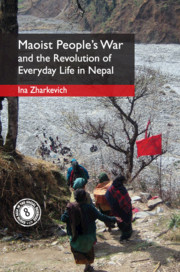Book contents
- Frontmatter
- Contents
- List of Figures
- Acknowledgements
- Glossary of Nepali Terms
- Introduction
- 1 Thabang: From Remote Village to Revolutionary Myth
- 2 The Moral Economy of War: The Making of the Base Area
- 3 Becoming Maoist in a Time of Insurgency
- 4 The Marital Economy of War: Reconfiguring Kinship Loyalties and Conjugality
- 5 Remaking the Tribe: ‘A Farewell to Bad Traditions’
- 6 Subverting the ‘Sacred Cow’: When Beef Becomes Edible
- 7 When All Castes Become One: Transgressing Caste Boundaries during War
- 8 When Gods Return to Their Homeland in the Himalayas: Maoism, Religion, and Change
- Conclusion
- Appendices
- Bibliography
- Index
2 - The Moral Economy of War: The Making of the Base Area
Published online by Cambridge University Press: 28 March 2019
- Frontmatter
- Contents
- List of Figures
- Acknowledgements
- Glossary of Nepali Terms
- Introduction
- 1 Thabang: From Remote Village to Revolutionary Myth
- 2 The Moral Economy of War: The Making of the Base Area
- 3 Becoming Maoist in a Time of Insurgency
- 4 The Marital Economy of War: Reconfiguring Kinship Loyalties and Conjugality
- 5 Remaking the Tribe: ‘A Farewell to Bad Traditions’
- 6 Subverting the ‘Sacred Cow’: When Beef Becomes Edible
- 7 When All Castes Become One: Transgressing Caste Boundaries during War
- 8 When Gods Return to Their Homeland in the Himalayas: Maoism, Religion, and Change
- Conclusion
- Appendices
- Bibliography
- Index
Summary
The People's War officially began on 13 February 1996 with attacks by a group of Maoist insurgents on police posts in the districts of Rolpa, Rukum, and Sindhuli and a government office in Gorkha (Ogura 2007: 435). However, for inhabitants of different parts of Nepal, the war became real at very different points in history. For inhabitants of the Kathmandu valley, for instance, the war was somewhat distant, even non-existent, up until the declaration of the State of Emergency in 2001. Similarly, for the ordinary villagers in the Maoist base area, the start of the conflict is hardly associated with chronological dates postulated now as the beginning of the People's War. In the words of Maya, a shrewd Kham Magar woman in her fifties, she would have told me the date of the arrival of the war in Thabang if ‘she knew the years’. Instead, like many Thabangis, Maya links the beginning of the war in Thabang to two distinct local events: the dispute over communal land in 1993 and the killings of two Maoist activists by the state in 1997. These events are commonly viewed by the local population as the actual beginning of the war and the point of no return for Thabang. I suggest that it is by analysing these two events that we can understand the process whereby Thabang was forged as a moral community of ‘reluctant rebels’ who supported the Maoist movement because of a complex interplay of interests based on not only ideological affinity but also moral solidarity, kinship allegiances, and compliance with the Maoist regime of power during the war.
Despite the fact that Thabang has been portrayed as a ‘village of resistance’ (Ogura 2007) and its people as ‘rebellious peasants’ who staged a series of peasant rebellions in the second half of the 20th century (Gidwani and Paudel 2012), I show that this reading of Thabang's history does not give due consideration to the complexity of power relations within the village, to the inequalities between the village notables and common people, and to the views of the peasants themselves.
- Type
- Chapter
- Information
- Publisher: Cambridge University PressPrint publication year: 2019



